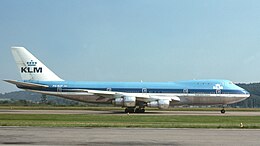 Wreckage of the KLM aircraft on the runway at Los Rodeos | |
| Accident | |
|---|---|
| Date | 27 March 1977 |
| Summary | Runway collision |
| Site | 28°28′53.94″N 16°20′18.24″W / 28.4816500°N 16.3384000°W |
| Total fatalities | 583 |
| Total injuries | 61 |
| Total survivors | 61 |
| First aircraft | |
 PH-BUF, the KLM Boeing 747-206B involved in the accident | |
| Type | Boeing 747-206B |
| Name | Rijn / The Rhine |
| Operator | KLM Royal Dutch Airlines |
| IATA flight No. | KL4805 |
| ICAO flight No. | KLM4805 |
| Call sign | KLM 4805 |
| Registration | PH-BUF |
| Flight origin | Amsterdam Airport Schiphol Amsterdam, Netherlands |
| Destination | Gran Canaria Airport Gran Canaria, Canary Islands |
| Occupants | 248 |
| Passengers | 234 |
| Crew | 14 |
| Fatalities | 248 |
| Survivors | 0 |
| Second aircraft | |
 N736PA, the Pan Am Boeing 747-121 involved in the accident | |
| Type | Boeing 747-121 |
| Name | Clipper Victor |
| Operator | Pan American World Airways |
| IATA flight No. | PA1736 |
| ICAO flight No. | PAA1736 |
| Call sign | CLIPPER 1736 |
| Registration | N736PA |
| Flight origin | Los Angeles International Airport Los Angeles, United States |
| Stopover | John F. Kennedy International Airport, New York City, United States |
| Destination | Gran Canaria Airport Gran Canaria, Canary Islands |
| Occupants | 396 |
| Passengers | 380 |
| Crew | 16 |
| Fatalities | 335 |
| Injuries | 61 |
| Survivors | 61 |
The Tenerife airport disaster occurred on 27 March 1977, when two Boeing 747 passenger jets collided on the runway at Los Rodeos Airport[1] (now Tenerife North Airport) on the Spanish island of Tenerife.[2][3] The accident occurred when KLM Flight 4805 initiated its takeoff run in dense fog, colliding with the rear of Pan Am Flight 1736 still on the runway. The impact and the resulting fire killed all 248 people on board the KLM plane and 335 of the 396 people on board the Pan Am plane, with only 61 survivors in the front section of the latter aircraft. With a total of 583 fatalities, the disaster is the deadliest accident in aviation history.[2][3]
The two aircraft had landed at Los Rodeos earlier in the day, and were among a number of aircraft diverted to Los Rodeos due to a bomb explosion at their intended destination of Gran Canaria Airport. The airport had become congested with parked airplanes blocking the only taxiway, forcing departing aircraft to taxi on the runway. Patches of thick fog were drifting across the airfield, so visibility was greatly reduced for pilots and the control tower.[2][3]
The subsequent investigation by Spanish authorities concluded that the primary cause of the accident was the KLM captain's decision to take off in the mistaken belief that a takeoff clearance from air traffic control (ATC) had been issued.[4] Dutch investigators placed a greater emphasis on a mutual misunderstanding in radio communications between the KLM crew and ATC,[5] but ultimately KLM admitted that their crew was responsible for the accident and the airline agreed to financially compensate the relatives of all of the victims.[6]
The disaster had a lasting influence on the industry, highlighting in particular the vital importance of using standardized phraseology in radio communications. Cockpit procedures were also reviewed, contributing to the establishment of crew resource management as a fundamental part of airline pilots' training.[7] The captain is no longer considered infallible, and combined crew input is encouraged during aircraft operations.[8]
- ^ Tedeschi, Diane (June 2019). "Crash in the Canary Islands". Air & Space Magazine. Retrieved 17 October 2019.
- ^ a b c "580 killed in history's worst air disaster". Eugene Register-Guard. (Oregon). Associated Press. 28 March 1977. p. 1A.
- ^ a b c "Dutch pilot blamed for air disaster". Eugene Register-Guard. (Oregon). Associated Press. 29 March 1977. p. 1A.
- ^ Cite error: The named reference
ASNwas invoked but never defined (see the help page). - ^ Cite error: The named reference
dutch_responsewas invoked but never defined (see the help page). - ^ Cite error: The named reference
KLM responsibilitywas invoked but never defined (see the help page). - ^ Baron, Robert. "The Cockpit, the Cabin, and Social Psychology". Global Operators Flight Information Resource. Retrieved 11 May 2011.
- ^ "The Tenerife Airport Disaster – the worst in aviation history". The Tenerife Information Centre. Archived from the original on 11 April 2022. Retrieved 29 October 2014.